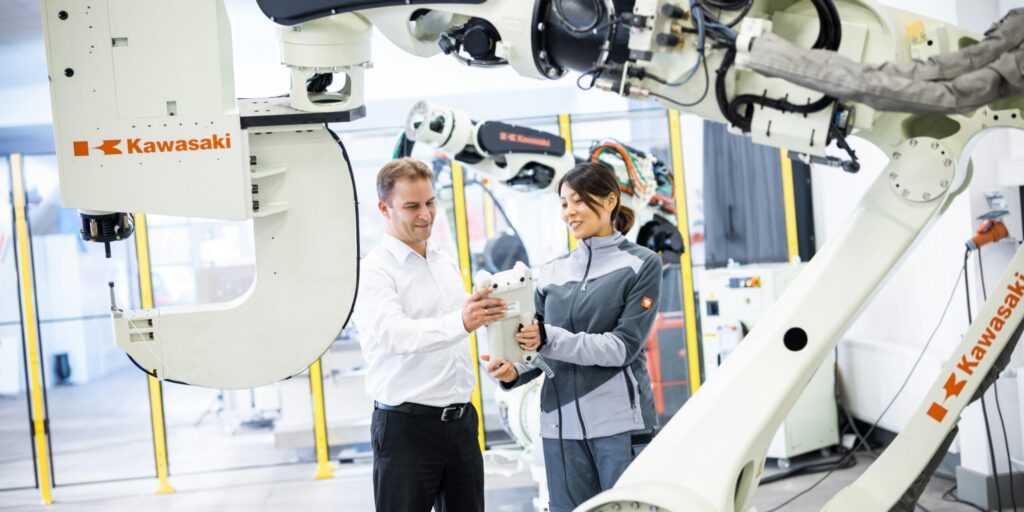The American manufacturing industry is undergoing a transformative shift in 2025, driven by advancements in artificial intelligence (AI), automation, and robotics. From improving production efficiency to reducing costs and enhancing product quality, AI is not only reshaping how products are made but also helping U.S. manufacturers stay competitive in a global economy. The integration of AI in U.S. manufacturing represents a broader trend toward digitalization and smart manufacturing, making the industry more agile, sustainable, and innovative.
AI’s Role in Revolutionizing Production Lines
One of the key areas where AI has had a profound impact is on production lines. In traditional manufacturing, processes were often static and required manual oversight. But AI-powered systems now help to optimize these processes by continuously analyzing data, making real-time adjustments, and ensuring that production runs smoothly with minimal human intervention.
For example, General Electric (GE) and Honeywell are two industry leaders who have embraced AI-powered systems to enhance their manufacturing capabilities. GE Aviation, a major supplier of jet engines, has implemented AI-driven predictive maintenance tools that monitor the health of machinery and predict when components are likely to fail. This enables the company to perform maintenance before a breakdown occurs, saving millions of dollars in potential downtime and repairs. The AI system also helps improve the efficiency of their assembly lines by reducing waste and optimizing resource use.
Similarly, Honeywell has introduced AI technology in its smart factories, which are designed to self-optimize production processes. These smart factories use machine learning algorithms to identify inefficiencies and automatically adjust operations to increase throughput while maintaining high levels of quality. This is particularly important in industries like pharmaceuticals and electronics manufacturing, where precision and quality control are critical.
Automation and Robotics: Enhancing Efficiency and Safety
Alongside AI, robotics and automation are central to the transformation of U.S. manufacturing. Automated robots, equipped with machine learning capabilities, are performing tasks that were once done manually, such as assembling components, welding, painting, and even packaging products. This automation not only improves efficiency but also enhances worker safety by taking on dangerous or repetitive tasks.
Tesla’s Gigafactories serve as a prime example of how automation and robotics can drive manufacturing efficiency. Tesla has integrated thousands of robots into its production lines, many of which work collaboratively alongside human employees to assemble electric vehicles. These robots perform a wide range of tasks, from installing parts to conducting quality checks, which has allowed Tesla to scale its production to meet growing demand for electric vehicles.
In addition to automotive manufacturing, robotics are increasingly being used in industries such as food processing, textiles, and even construction. In fact, a 2025 report from the National Association of Manufacturers (NAM) revealed that nearly 50% of U.S. manufacturers have adopted or are planning to implement robotics and automation in their operations.
While automation has raised concerns about job displacement, it has also created new opportunities for workers with advanced technical skills. Many manufacturers are offering upskilling and reskilling programs to help workers adapt to the new technological landscape. For example, Boeing and Caterpillar have partnered with local community colleges to provide training in robotics, AI, and advanced manufacturing techniques, ensuring that workers are prepared for the future of manufacturing.
AI and the Supply Chain: Real-Time Insights and Decision-Making
Beyond the production line, AI is also revolutionizing supply chain management, helping manufacturers make smarter, data-driven decisions. In a world where supply chains are becoming increasingly complex due to globalization and shifting market demands, AI’s ability to process vast amounts of data in real time is a game-changer.
For example, companies like Amazon and Walmart have integrated AI into their supply chain management systems to predict demand more accurately, optimize inventory levels, and reduce transportation costs. AI algorithms analyze historical data, weather patterns, and even social media trends to forecast consumer demand and adjust inventory accordingly. This enables companies to respond quickly to changes in consumer behavior, improving customer satisfaction while minimizing waste.
AI is also enhancing visibility across supply chains. Manufacturers can now track raw materials, finished products, and even shipments in real-time, allowing for faster response times in the event of delays or disruptions. This is particularly important in industries like automotive manufacturing, where just-in-time inventory systems are used to keep production costs low. AI-powered predictive analytics can help companies anticipate supply chain disruptions, such as shipping delays or material shortages, and take proactive measures to minimize the impact on production.
The Future of AI in U.S. Manufacturing
The future of AI in U.S. manufacturing looks bright, with new technologies continuously emerging to further optimize production processes. One area of innovation is in the field of generative design, which uses AI algorithms to create new product designs based on specified parameters. For instance, instead of designing products manually, engineers can input variables like weight, material, and strength, and AI will generate a range of optimized designs that meet those requirements. This has the potential to revolutionize industries such as aerospace and automotive manufacturing, where lightweight, high-strength materials are critical.
Another area of potential growth is the integration of AI with the Internet of Things (IoT). In 2025, many U.S. manufacturers are using IoT sensors to collect data from machines and production lines. When paired with AI, these sensors can provide actionable insights that improve operational efficiency. For example, AI systems can analyze data from IoT sensors to detect patterns of inefficiency, such as equipment breakdowns or energy waste, and automatically make adjustments to improve performance.
As AI becomes more advanced, manufacturers will also have access to greater insights into customer preferences, allowing them to tailor products and services more effectively. With the ability to collect and analyze data from multiple sources—ranging from customer feedback to sensor data—AI will help manufacturers create more personalized, high-quality products that meet the unique needs of individual customers.
Challenges and Ethical Considerations
Despite the many benefits, the integration of AI in manufacturing comes with its own set of challenges. One of the main concerns is the potential for job displacement. As machines become more capable of performing tasks traditionally done by humans, there is the risk of significant job losses, especially in lower-skilled positions.
Moreover, the widespread use of AI in manufacturing raises ethical concerns about data privacy and security. Manufacturers are collecting vast amounts of data from workers, machines, and supply chains, and ensuring that this data is protected from cyberattacks is essential. Additionally, the algorithms used in AI systems can sometimes be biased, leading to unfair or inaccurate decision-making. Manufacturers must take steps to ensure that AI systems are transparent, accountable, and free from bias.
Conclusion
AI is undoubtedly reshaping the future of U.S. manufacturing. By improving efficiency, enhancing product quality, and providing real-time insights into supply chain management, AI has become a critical tool for manufacturers seeking to stay competitive in the global market. While challenges remain, the continued integration of AI into the manufacturing sector promises to drive innovation and growth in the years to come. As manufacturers embrace these technologies, the future of U.S. manufacturing looks brighter than ever before.


